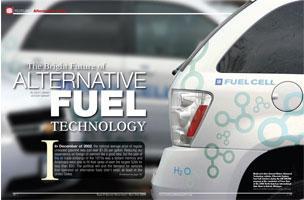
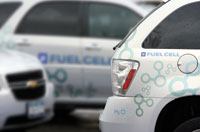 In December of 2002, the national average price of regular unleaded gasoline was just over $1.00 per gallon. Reducing our dependence on foreign oil seemed like a good idea, but the pain of the oil trade embargo of the 1970s was a distant memory and Americans were able to fill their tanks of even the largest SUVs for less than $50. The political will and the demand for vehicles that operated on alternative fuels didn’t exist, at least in the
In December of 2002, the national average price of regular unleaded gasoline was just over $1.00 per gallon. Reducing our dependence on foreign oil seemed like a good idea, but the pain of the oil trade embargo of the 1970s was a distant memory and Americans were able to fill their tanks of even the largest SUVs for less than $50. The political will and the demand for vehicles that operated on alternative fuels didn’t exist, at least in the
The dramatic price increases that topped out at more than $4.00 per gallon in the summer of 2008, as well as our growing awareness of the reality of climate change, changed all of that. Suddenly, reducing the pain at the pump was front and center once again in the minds of politicians, automotive companies and the general public.
Currently, technology research in autos and trucks centered on reducing carbon greenhouse gas emissions and the
The alternative fuel technologies that are currently being investigated range widely, some showing much more promise than others. Ethanol as an additive or a primary fuel, for example, has been widely touted and even subsidized by government programs. However critics argue that the reduction in greenhouse gases from this cleaner burning fuel are more than offset by the gases that are emitted in the production of the fuel itself, not to mention the effect that it has on diverting the world’s food production capacity to growing corn for fuel. In addition, because of its lower energy content, ethanol as a car fuel reduces car mileage 20 to 30 percent versus gasoline.
Three newer alternative fuel technologies seem to have a bright future however: bio fuel made from cellulosic materials; bio diesel made from plant oil or animal fats; and ultra low sulfur diesel from natural gas or coal.
Engine Technologies
The fuel source is not the primary concern of the Original Equipment Manufacturers (OEMs). On the contrary, they are more concerned with what type of engine they should plan for their vehicles. Dr. Paul J. Venhovens, BMW chair in Systems Integration at the
Four engine technologies currently show the most promise for long-term viability and reduction of greenhouse gases and dependence on foreign oil. They are standard gas engines using a bio gasoline fuel; engines that burn clean diesel; hybrid and plug-in hybrid with either gasoline or diesel engines; and all-electric vehicles. All four of these have their challenges, and all have their benefits.
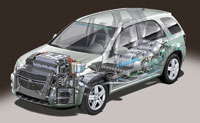 Not included in these are vehicles powered by hydrogen fuel cells. These have been talked about for some time and much research has been completed, but the issues of creating a totally new network of fuel centers and the limitations of the technology seem to have pushed this technology to the back burner compared with other fuel and engine technologies that can be incorporated into existing infrastructure. Hydrogen is certainly plentiful, and when burned as a fuel has no emissions. But, it takes energy to create hydrogen fuel, and depending on how that energy is created, hydrogen as an alternative can be very environmentally friendly or anything but.
Not included in these are vehicles powered by hydrogen fuel cells. These have been talked about for some time and much research has been completed, but the issues of creating a totally new network of fuel centers and the limitations of the technology seem to have pushed this technology to the back burner compared with other fuel and engine technologies that can be incorporated into existing infrastructure. Hydrogen is certainly plentiful, and when burned as a fuel has no emissions. But, it takes energy to create hydrogen fuel, and depending on how that energy is created, hydrogen as an alternative can be very environmentally friendly or anything but.
Each of these fuel and engine technologies also has an impact on where and how capital investment will be taking place. The increase in hybrid and electric vehicles, for example, will mean that more and better batteries will have to be produced. And recharging stations may become as common as fuel stations are today.
Each of these technologies and their potential impact on capital investment will be investigated in this article.
Diesel
Perhaps the easiest alternative fuel to comprehend and switch to is ULSD (ultra low sulfur diesel) also known as clean diesel. The modern diesel engine technology, which had the reputation of being dirty and unreliable in the 1980s, has advanced tremendously in the last 10 years. At the same time gas prices were low in the
The chief advantage of diesel lies in the engine technology which has a higher compression ratio resulting in a more efficient engine operation and higher gas mileage per gallon. Additionally, diesel fuels contain about 10 percent more energy than a gallon of gas, further increasing the mileage advantage. The results are a bit stunning! For example, a Honda Accord with a 2.2 liter i-CTDi diesel engine is rated at 43.3 MPG, versus the same Honda Accord with a 2.4 liter gasoline engine rated at 29.0 MPG – an increase in 49 percent in gas mileage by just changing engines!
This technology is clearly ready for delivery, is proven and has only a small penalty of increased price in the smaller 4-cylinder versions of the engine. Larger diesel engines require a NOX SCR system that adds to the price and complexity of the diesel. The present problem is that this technology is not widely available in the
Hybrid, Plug-In Hybrid and All-Electric
Any discussion of these three technologies must start with battery technology and some of its limitations. This information is summarized from a recent presentation by Dr. Venhovens at the Power Systems Conference, Clemson in March 2009.
For typical Plug-in Hybrid Electrical Vehicles (PHEVs), about 16 kWh of electric batteries will be required for a 40-mile, all-electric driving range, weighing about 400 pounds and costing presently over $8,000 dollars. But these batteries have a few limitations.
First, they typically have an effective usable capacity of only a little over 55 percent because the electrodes must be protected from either over-charging or deep discharge, limiting the effective kWh to about 8.8.
Second, the batteries operate best when their temperature is 77º to 95º. So the batteries need to be conditioned (plugged-in) for colder temperature (below 50º) or much of the electric benefits could be lost.
Finally the cars must be plugged in or the batteries will self-discharge, typically 5 percent per week. So the plug-in hybrids and all-electric vehicles need relatively wide availability of charging stations or plugs to work most effectively.
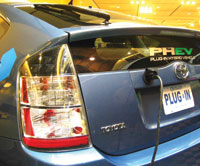 Plug-in Hybrid vehicles are not yet in production and are not available to the
Plug-in Hybrid vehicles are not yet in production and are not available to the Improved battery technology could make dramatic improvements in the cost and functionality of electric vehicles. Several different battery technologies are in use and in development including sodium nickel battery systems and lithium batteries in various forms. Again, siting opportunities for companies producing these batteries and raw materials supplies will exist.
Despite the challenges, all-electric cars offer significant advantages. The primary advantage is that an electric car can be charged at night for about 36 to 72 cents for 40 to 45 miles of driving range (assuming a 4 to 8 cent per kWh electric cost at night and a 9 kWh charge). The electric engine produces no direct emissions – it has no tail pipe and uses no gas while in the electric mode. Finally the total emissions produced including the emissions from the production of the electricity are much lower than any other engine system.
As many as 50 forms of electric vehicles are on the drawing boards and many new OEMs may open shop to produce these vehicles. One example is
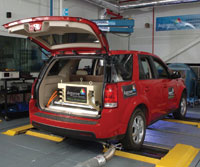 Hybrid cars are already in production and available to the
Hybrid cars are already in production and available to the
Alternative Fuel Technologies
The second area of technological research and investment that is being made to further reduce our carbon footprint and reduce our dependence on fossil fuels is in alternative fuel technologies.
Diesel Opportunities
Ultra low sulfur diesel has been mandated by the
Another concern has been the availability of service stations with diesel fuel pumps. All of these issues can be overcome; however, diesel is still a non-renewable imported fuel. If diesel takes off in this country, more refiners in the
But, diesel could also be produced by the conversion of natural gas, a technology under investigation by Shell, or by the conversion of oils and animal fats into biodiesel. Biodiesel is a known technology that is presently available in the
BioFuel
Production of fuel ethanol or other gasoline alternatives from cellulosic materials such as switch grass, miscanthus or other benign crops that don’t take away from the food chain, has received an estimated $437 million in venture capital investment in 2008 according to Biofuels Digest. Verenium Corporation will start construction of a commercial cellulosic ethanol in
So Now What?
 Significant investment opportunities exist in almost all areas of engine, fuel and car technologies. Electric cars seem to be offering the opportunity for many more OEMs to locate or develop in the
Significant investment opportunities exist in almost all areas of engine, fuel and car technologies. Electric cars seem to be offering the opportunity for many more OEMs to locate or develop in the As technology develops, significant investment in alternative fuel production from non-food crops or recycled materials will continue to increase. The silver bullet technology to reduced emissions and oil dependence already exists – all electric cars or gas or ULSD diesel and plug-in hybrid with a bio fuel – now someone has to offer the technology and Americans have to buy it.


